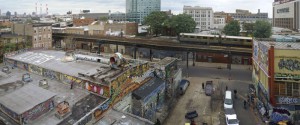When visiting the Metropolitan Museum of Art I found the exhibit: Faking It, to be very strange, but interesting. The way a photograph can be manipulated into different ways to trick the human eyes is unbelievable. The way people faked a photo was by adding people to a scene or adding anything that was never created into a photo. Everything was done manually until computers were introduced and the inventions of software took off in the later years.
The one photograph that caught my attention was the Dirigible Docked on the Empire State Building. It’s a landscape photo of the Empire State Building and New York City skyscraper. The photo had some shadows, dark tones and high contrast. The white and black color made it look scary as while. However, what caught my attention was the blimp that was on the peak of the Empire State Building. Its looks scary because to me it looked like an alien spaceship on top of the building. After looking closer to it was a U.S. Navy blimp but it was strange that a blimp can be balance on the peak. In result, I knew it was a fake photograph because first, you can tell the blimp was adding onto the building, second, no airships ever landed on top of the building and lastly, it was usually for an aircraft to fly that low. Taking everything under consideration I knew it was a fake photo. The reason for it was to make the Empire State Building a popular site in New York and to draw attention for people to visit. Also, they wanted the Empire State Building to be the best skyscraper in New York and take out the Chrysler Building who people thought that was best building at that time. When Empire State Building was built the creator thought by them adding a blimp that it would’ve lasted along time but the fake report surfaced and then it was edited.
The process that was used in the photograph was called photomontages which mean they take two different elements from each photos and combine them into one piece. In other words, it a kind of collage that is composed of the photographs or fragments of photographs in order to direct the viewer’s mind such as the blimp on the Empire State Building. The reason why photomontages was used because bringing two different images into one image can bring the message of the photo and to trick how the mind may think of a photograph. In today’s world, creating a photomontage is much easier than before; you now have software such as Adobe Photoshop, Paint Shop Pro, Photo paint or GIMP.
The Metropolitan Museum of Art was a great experience; I got a better understanding on how photograph was manipulated and the process behind it. The way photographers transformed two different images into one creative image is amazing. In today’s world the way you fake a photograph so much different than before. Before you would have to create a fake photograph manually by cutting out the images and pastes it together. Now you have Photoshop which is much easier than manually doing it and it does all the work.






